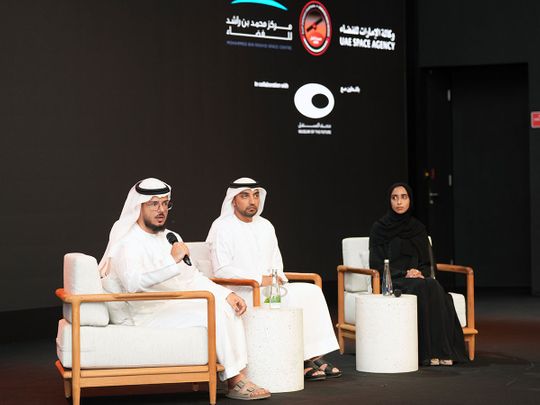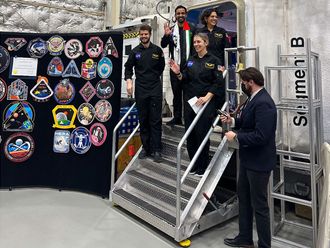
Dubai: The UAE’s Hope Probe has achieved its primary target of operating two years in Martian orbit and the Emirates Mars Mission has been extended to study the Mars’ moon and gather more data on the red planet’s atmosphere, it was announced on Thursday.
Celebrating two years of orbiting the Red Planet on February 9, the Emirates Mars Mission ‘Hope Probe’, the first Arab-led planetary exploration mission, is transitioning to a new orbit, top officials said at a press conference.
The orbital transfer will allow the Hope Probe to fly within approximately 150km and capture unprecedented data on Deimos, the smaller and outermost of the two natural satellites of Mars.
The Hope Probe successfully reached Mars’ orbit at 19:42 on February 9, 2021, completing one of the most complex and intricate stages of its mission, after covering 493 million kilometres over a seven-month journey through space.
“We are done with the operation for one Martian year [nearly two Earth years on Mars’ orbit] as planned,” Mohsen Al Awadhi, director of Space Missions Department at the UAE Space Agency told Gulf News.
Possible extension for 2 years
“The Hope Probe has accomplished what it needed to by doing the operation, the observations, taking photos and data, but releasing that data is still not accomplished as it takes about six months. So whatever we have released today is six-months-old,” he explained.
Speaking about the plan to extend the Emirates Mars Mission (EMS), he said: “By mid-last year, we started assessing the spacecraft and the instruments to see if we can think about extending the mission and we found everything is good, all green. We can actually continue for at least one more Martian year, that is two years on earth. We are now in talks with the team to see how we can move forward with that. That’s why nothing is stopped. As long as it is working, EMS will continue and we see it as an asset for the UAE government. Definitely, the funding and paperwork need to be in place. You know, these things normally take some time and that’s where we are today. So we can, Insha Allah, soon announce about the path forward.”
Chancing upon Mars’ moon
The Hope Probe will now move to a new elliptic orbit around Mars, following a Lambert orbital transfer maneuver utilising the change in its velocity.
What is described as a “historic move” is the result of an opportunity to study about Deimos that came along during the course of the mission, Al Awadhi revealed.
Exploring Deimos was not part of the baseline of the EMS, he said. “We never put it in the baseline back when we started the mission. But we knew the orbit and that there might be an opportunity, but we never announced anything because we didn’t want to over-promise anything. Today, as we complete one Martian year, it is right time now to do something extra without impacting the objectives of the mission. So I think as long as the science community sees benefit from these data, the team will continue to do it. The importance and focus will be on the science of Mars. But whenever a possible opportunity exists, the team can support with more data on Deimos.”
Capturing Deimos
Zakaria Al Shamsi, project director at EMS, said the spacecraft had maneuvered its orbit “only a little bit” to capture Deimos without affecting its view of Mars as the objective of the original mission was to be on the ‘science orbit’ of Mars.
“Other missions have very little data about Deimos. We would love the UAE to be participating in this and help the scientific community to discover more about Deimos,” he said.
Deimos is the least observed compared to the red planet’s second moon, Phobos, which has been widely observed since its discovery in 1969. Orbiting Mars on a larger orbit, Deimos completes a revolution around the planet every 30 hours.
Hessa Al Matroushi, science lead at EMS, said the Deimos campaign by EMS aims to provide the international scientific community with previously unseen observations and data. “The Hope Probe will capture high cadence images and data of the irregularly shaped, crater-heavy moon, during fly-bys at different times.”
Fly-by and maneuvers
The first Deimos fly-by began late January and continues through February 2023. As the Probe moves to its closest approach to the moon, this allows the Hope Probe’s Emirates Exploration Imager (EXI), Emirates Mars Ultraviolet Spectrometer (EMUS), and the Emirates Mars Infrared Spectrometer (EMUS), to capture high cadence images and detailed observations of the moon.
To enable the orbital transfer maneuver, the Hope Probe completed two out of three maneuvers using its main thrusters in September 2022 and January 2023, marking the first time the thrusters were activated remotely to make the necessary orbital corrections.
The Hope Probe orbits Mars currently in its elliptic orbit between 20,000 and 43,000 km with a 25-degree incline towards the planet, giving it the unique ability to complete one revolution around the planet every 55 hours, capturing comprehensive data every nine days. The slight change in the Probe’s orbit will allow it to capture new observations of Deimos, while capturing data on the red planet’s atmosphere.
In fact, the Deimos fly-by burns change Hope’s orbit so minimally that the entirety of the primary mission objectives remain completely unaltered.
The Hope Probe is the culmination of the national space sector’s development and knowledge transfer efforts, which began in 2006. Emirati engineers collaborated with international partners to design and develop the UAE’s space crafts and national manufacturing and engineering capabilities.
The Probe is equipped with three measurement tools to analyse Mars’ atmosphere. Weighing 1350 Kg, equal to a small SUV, the Probe was designed and developed by the engineers of Mohammed Bin Rashid Space Centre (MBRSC), in cooperation with partners from leading international academic institutions, including the Laboratory of Atmospheric and Space Physics, University of Colorado Boulder, Space Sciences Laboratory (SSL), University of California, Berkeley, and Arizona State University (ASU).
Milestones
The Emirates Mars Mission has so far issued six batches of data on the red planet. The first batch size was 110 Gigabytes and was released on October 1, 2021, while the second batch size was 76.5 Gigabyte and was released on January 12, 2022.
The 57-Gigabyte third batch of data was announced on April 1, 2022, while the fourth batch offered 118.5 Gigabytes of data. The fifth batch of data provided the scientific community with 236.8 Gigabyte of data.
The sixth batch of data offered several observations, which were captured by the Probe’s Emirates Mars Ultraviolet Spectrometer (EMUS), and the Emirates Mars Infrared Spectrometer (EMIRS), while the Emirates Exploration Imager (EXI) captured high cadence images of high dust movement on Mars, on June 6, June 13, June 22, June 27, July 13, July 22, and August 12, 2022. A series of EXI colour composites taken over about six hours on September 24 revealed a massive dust storm and dense fog covering Valles Marineris and the surrounding areas from early morning hours until noon, as well as the rapid evolution of the storm. Valles Marineris, or Mariner Valley, is a vast canyon system that runs along the Martian equator.












